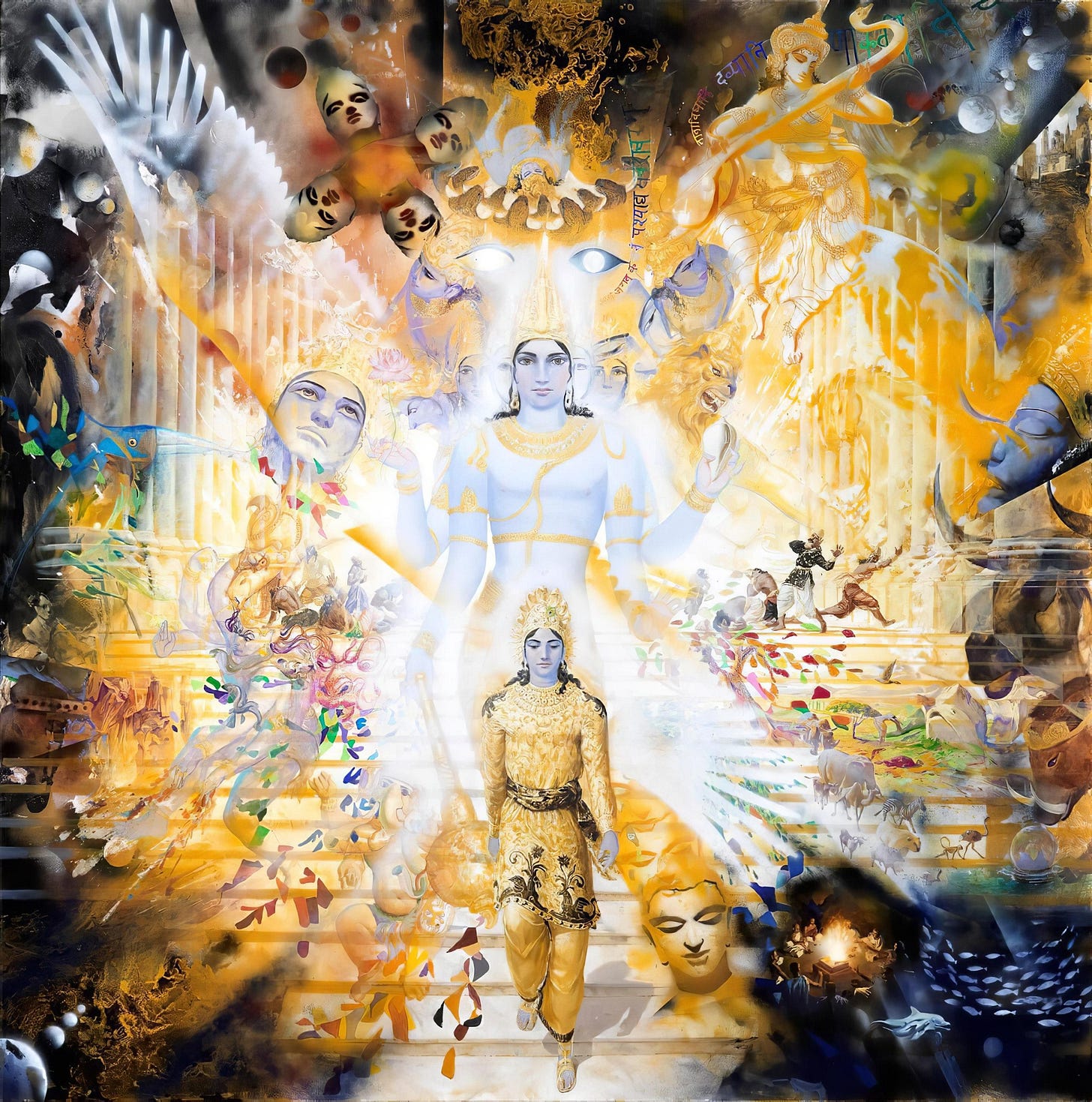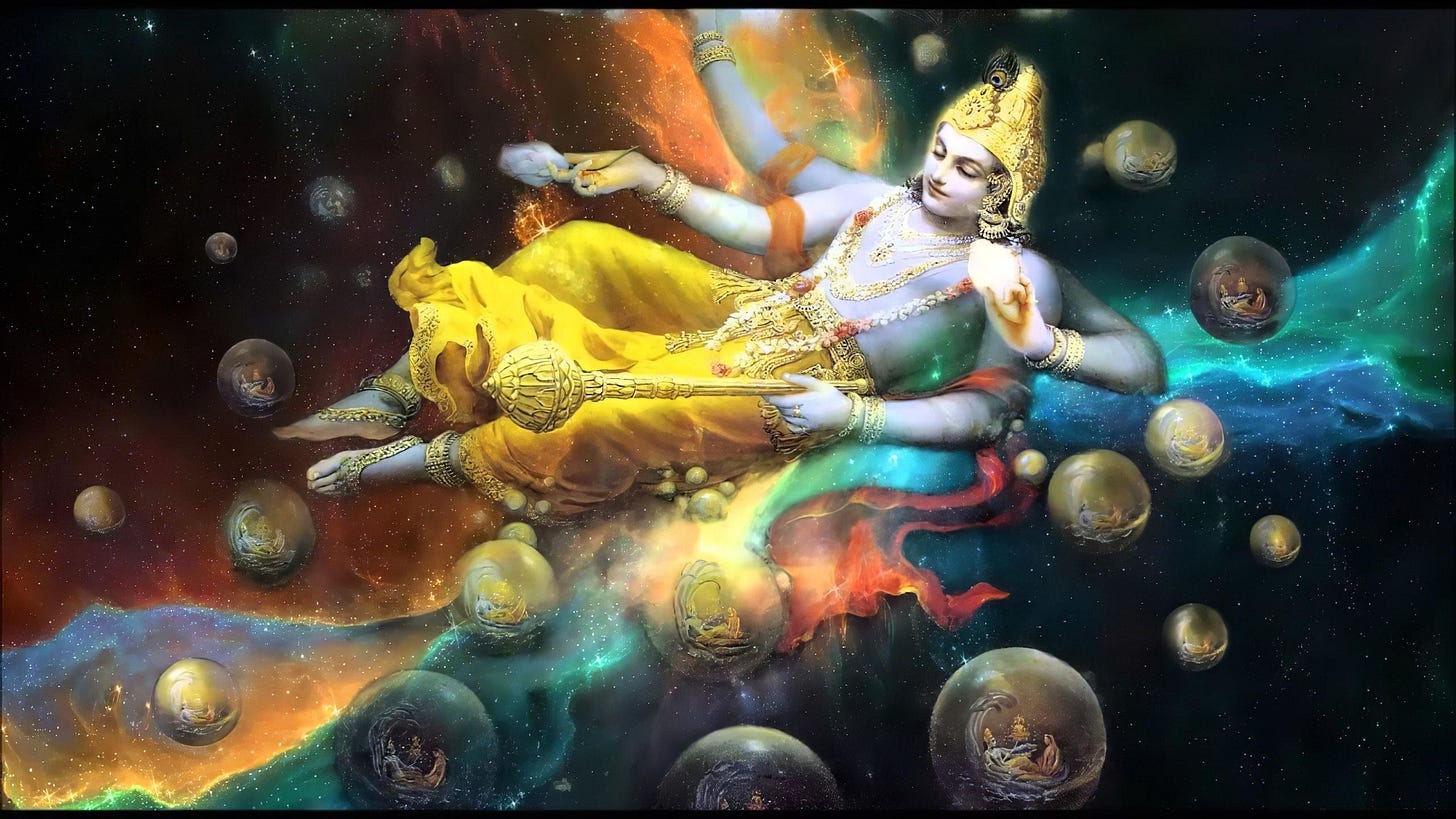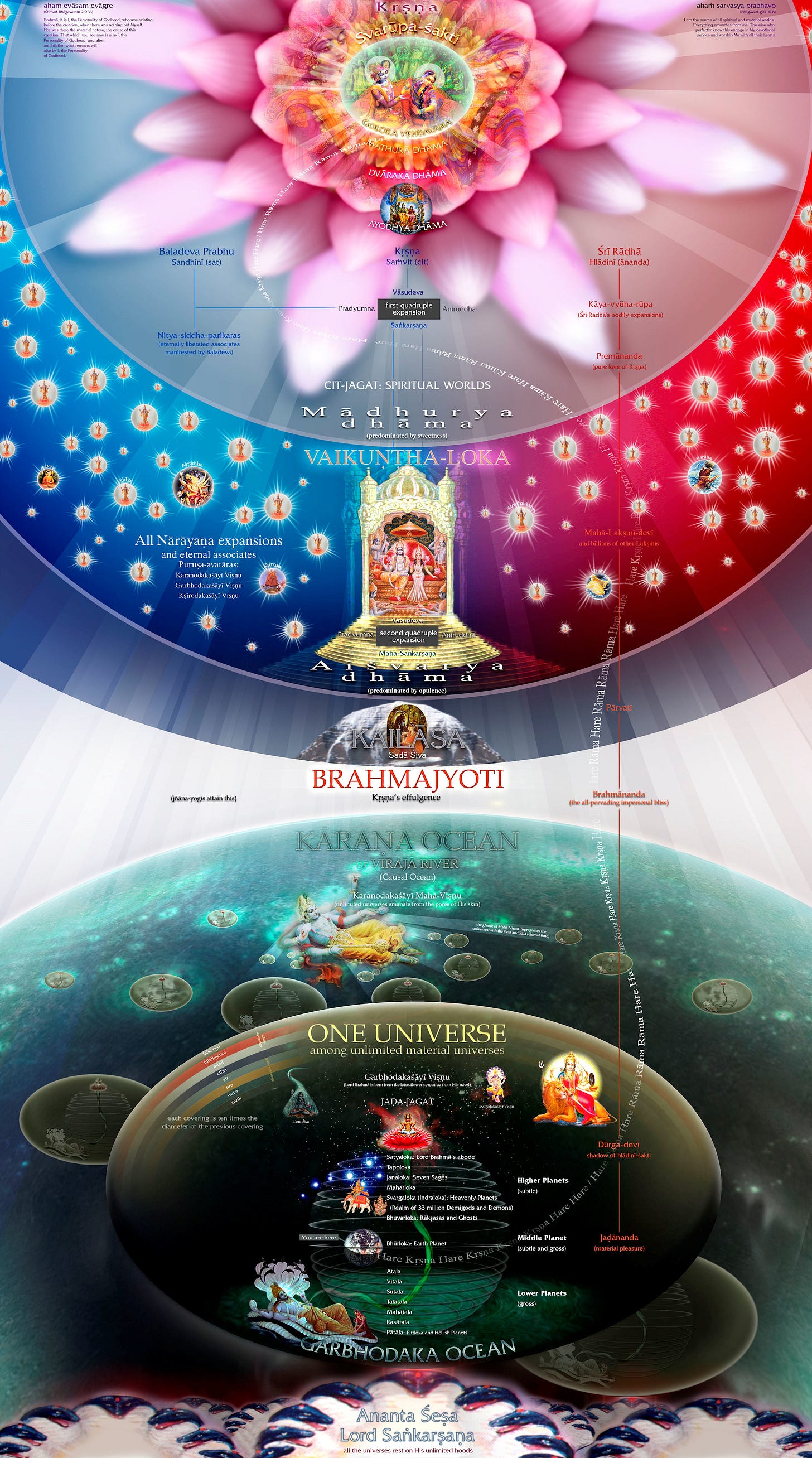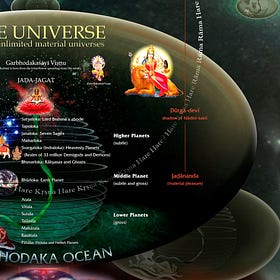How Krsna creates the material universes without anything apart from Himself?
When we create something, we use materials and tools that are available. However, when Krsna created the material universe, He was alone; nothing else existed. How did He do it?
When we create something, we use materials and tools that are available. When we build a house, for example, we buy bricks and other construction materials and just do the work of construction. Even if one does everything from zero, making also the bricks and everything else himself, still one takes materials from the ground, such as clay.
However, when Krsna created the material universe, He was alone; nothing else existed. How then could He create it, without using any tool or construction material apart from Himself?
First of all, the Lord possesses unlimited potencies. That’s the first point in understanding how He can create something apparently out of nothing, and understand how exactly He did it.
Krsna has many different potencies, which are all part of Himself. Here is nothing separate from Krsna, and thus, when Krsna desires to create something, He does it using some of His potencies, which are not different from Himself. He is thus the creator and also the ingredient, just as a spider creates its web from its own silk.
These potencies are grouped into three groups: the internal potency (antarangā-śakti), which includes all the spiritual planets, pastimes, and paraphernalia, the external potency, or material nature (bahiranga-śakti), and the marginal potency (taṭasthā-śakti), which are the individual souls, who are free to take shelter on one or the other.
All the spiritual planets, as well as the Brahman refulgence and so on, are part of the spiritual potency. Everything there is eternal, blissful, and full of knowledge. There is no creation, no destruction, and no ignorance there. All the individual souls are originally part of this internal potency, but we can come in contact with the external potency due to free will. The external potency includes both matter and Māyā, the illusory potency, which makes the souls identify with it. Māyā can cover the individual souls who choose to forget their eternal relationship with Krsna, but the Lord is always transcendental to it, and she remains always under His complete control. The function of māyā is to create an alternate, illusory world, where the forgotten jīvas can play.
The causal ocean
After the spiritual realm, there is the causal ocean (kāraṇodaka), the abode of Lord Mahā-Viṣnu, which, although also spiritual, represents the very border between the spiritual world and the material creation. Lord Vāmanadeva created a crack in the coverings of the universe when He kicked it, allowing this spiritual water to enter the universe in the form of the river Ganges.
The causal ocean is sometimes compared to a cloud that “covers” part of the spiritual sky. In this analogy, the impersonal Brahmajyoti, the light that emanates from Krsna’s body and all spiritual planets, is like sunshine, which engulfs the whole transcendental realm, and the causal ocean is like a rain cloud that covers a small part of it. Lord Mahā-Viṣnu lies on this ocean (or cloud), absorbed in His yoga-nidrā, or mystic slumber. However, His “sleep” is not a state of unconsciousness like ours, but a mystic state where He associates with His internal potency. Therefore, even while “sleeping”, He casts His glance over the external potency and produces the whole material creation.
The causal ocean is also described as the virajā river, giving the idea of a border between the spiritual and material realms. In the metaphor, one of the banks represents the spiritual world, and the other the material energy, the external potency of the Lord.
Prabhupada explains: “Virajā is a river that divides the material world from the spiritual world. On one side of the river Virajā is the effulgence of Brahmaloka and innumerable Vaikuṇṭha planets, and on the other side is this material world. It is to be understood that this side of the Virajā River is filled with material planets floating in the Causal Ocean. The name Virajā indicates a marginal position between the spiritual and material worlds, but the Virajā River is not under the control of the material energy. Consequently, it is devoid of the three guṇas.” (CC Madhya 15.172 purport)
The process of creation
From our point of view, there are many planetary systems beyond our planet, including Bhuvarloka, Svargaloka, Maharloka, Janaloka, Tapoloka, and Brahmaloka, which are progressively larger and more distant. After all these different planetary systems, there are the seven coverings of the universe, each one ten times larger than the previous. Beyond the last covering is the causal ocean, which is inconceivably large. Beyond the causal ocean is the impersonal Brahmajyoti, and beyond it are the Vaikuṇṭha planets and Goloka Vṛndāvana.
As explained in the Brahma-samhitā, the Lord does not come in direct contact with the illusory potency, which lies beyond the borders of the causal ocean. The work of creation is performed by the mere look of Lord Mahā-Viṣnu, who inseminates the material energy with the time-energy (kāla), Śambhu, and the jīvas who desire to participate in the material creation.
The look of Lord Mahā-Viṣnu is personified in the form of Lord Sadaśiva, who associates with the material nature and becomes the father of all living entities. Because of this association with the material energy, Lord Śiva is compared to yogurt, which is nothing but milk, but can’t be used in the place of milk. Lord Sadaśiva is originally Viṣnu-tattva, and has his eternal abode on the spiritual side, where he eternally glorifies the Lord. However, when he comes in contact with the material energy and expands himself in the numerous Śivas inside each material universe, part of his qualities are covered.
Apart from Māyā, another feature of the external potency is pradhāna, the unmanifested, undifferentiated amalgamation of all material elements, which remains dissolved in perfect equilibrium. Pradhāna is the material energy in its dormant state, with no variety, no activity, and no manifestation of the three material modes. Pradhāna exists beyond the causal ocean, on the material side. Sometimes it is described as being on top of the waters, but without touching them.
This pradhāna is agitated by the look of Lord Mahā-Viṣnu, which activates it, leading to the manifestation of the three material modes. The contact with kāla (eternal time) leads to a series of permutations, resulting in the appearance of the material elements. These elements amalgamate with the seeds of the universes that emanate from the breath of Mahā-Viṣnu, resulting in the many material universes in their inactive state.
These innumerable universes float on top of the causal ocean, just like many balls or bubbles floating on water. Another analogy that is sometimes made is with a board of styrofoam floating on water, since styrofoam is also composed of many small bubbles.
Once pradhāna becomes active (starting with the manifestation of the three material modes), it is called mahat-tattva, or prakṛti. These three words thus describe the same material nature, but in different stages. The word prakṛti is also used as a generic term for the material energy, as a potency of the Lord.
To activate the material universes, Mahā-Viṣnu enters each of them as Garbhodakaśāyī-Viṣnu, who in turn expands as Kṣīrodakaśāyī-Viṣnu (Paramātmā), powering the whole cosmic manifestation and acting as the source of all incarnations that appear in each particular universe. As explained by Lord Kapila in the third canto of Srimad-Bhagavatam, the Lord becomes present as Garbhodakaśāyī-Viṣnu and Kṣīrodakaśāyī-Viṣnu inside of each universe as a reflection, and not directly. In this way, the principle that the Lord never associates with the material energy remains valid.
Once creation happens, the cosmic manifestation remains active for 311.04 trillion years, the lifetime of Brahma. When the creation is withdrawn, the souls merge back into the body of Mahā-Viṣnu for a very long sleep during the inactive phase of the material manifestation, and the material energy returns to its original state as pradhāna. In this way, the material energy is never really transformed; it is just assembled into the material manifestation, and later returns to its original state, just like a bar of gold hammered into different objects and later melted back into the original form.
Merging into Mahā-Viṣnu
The idea of the jīvas merging into the body of Mahā-Viṣnu may sound strange at first, but it doesn’t mean they lose their identity. It’s just like a fish entering the ocean, or a bird entering a tree. It just describes proximity, and not loss of identity. Prabhupada explains this point later in the same purport:
“The merging of the living beings into the body of Mahā-Viṣṇu takes place automatically at the end of Brahmā’s one hundred years. But that does not mean that the individual living being loses his identity. The identity is there, and as soon as there is another creation by the supreme will of the Lord, all the sleeping, inactive living beings are again let loose to begin their activities in the continuation of past different spheres of life. It is called suptotthita-nyāya, or awakening from sleep and again engaging in one’s respective continuous duty. When a man is asleep at night, he forgets himself, what he is, what his duty is and everything of his waking state. But as soon as he awakens from slumber, he remembers all that he has to do and thus engages himself again in his prescribed activities. The living beings also remain merged in the body of Mahā-Viṣṇu during the period of annihilation, but as soon as there is another creation they arise to take up their unfinished work. This is also confirmed in the Bhagavad-gītā (8.18-19).”
In this way, we can see that all the components of the material creation are different potencies of the Lord. Mahā-Viṣnu is His expansion, who lies on the causal ocean, which is a feature of His spiritual potency. Both pradhāna and māyā are features of His external potency. The time-energy and the jīvas are also potencies of the Lord, just as Lord Sadaśiva. The material elements and the cosmic manifestation itself are nothing more than the same material energy previously present in the pradhāna after being agitated by the contact with these different potencies.
The material energy is also spiritual in nature, being one of the potencies of the Lord. However, the presence of Māyā, the illusory potency, makes the jīvas see it as separate from the Lord, as an object of their enjoyment. This is what makes the cosmic creation appear material. The material creation is thus illusory, due to the presence of Māyā, but it is not false. The Lord appears inside of it in many different incarnations, but He never comes in contact with the material energy and never falls under the control of Māyā. Because He remains transcendental, He can give liberation to the jīvas who desire to be reinstated in their original position of service to the Lord.
You can also donate using Buy Me a Coffee, PayPal, Wise, Revolut, or bank transfers. There is a separate page with all the links. This helps me enormously to have time to write instead of doing other things to make a living. Thanks!
Read also:
The enigmatic description of the universe from the 5th canto of Srimad Bhagavatam
Did you ever have doubts about the way the Srimad Bhagavatam describes the universe? Does the idea of the giant flat island of Jambūdvīpa, balanced by four elephants dividing the universe in two vertical halves, raise some doubts in your mind? Do statements from Srila Prabhupada that men never went to the moon ever leave you a little bit confused?





